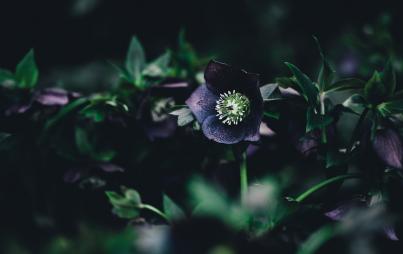
Photo by Jen Theodore on Unsplash
This article first appeared on Luna Luna and has been republished with permission.
I've always been intrigued by tarot cards, especially as they relate to tarot for self-care and introspection. In fact, some of my favorite books are approaching tarot as a healing tool — like the new Tarot for Self Care by Minerva Siegel and Tarot for Troubled Times by Theresa Reed and Shaheen Miro. And if you’re looking for an inclusive, healing deck, here are some excellent resources for the tarot enthusiast or the curious. Also, please make sure you check out The Hoodwitch. Also be sure to read all of our tarot content, including Joanna C. Valente’s tarot horoscopes.
For the longest time, I've turned to tarot cards — usually read by someone else for me — to seek wisdom. I was recently invited to The Witches Almanac Witches Masquerade Ball in Massachusetts (alongside Laura Tempest Zakroff, Christopher Penczak, and Harold Roth), where I received two tarot readings that essentially amounted to one lesson I’d been putting off learning: Stop only identifying with and relying so heavily on the dark; you forget to let the light in. And it’s true.
I don't personally believe that the tarot cards are in communication with some divine force, deity, ancestor or Spirit (although many people do, and that's awesome), but I do believe that pulling a card randomly generates a message or lesson on which I can reflect. In either case, it's divinatory in some sense.
In fact, writer, Strega, tarot reader (and my Astrolushes podcast co-host!) Andi Talarico put it beautifully:
Do I use tarot as divination or reflection? The short answer is both, for sure, though I'm less concerned with fortune-telling than I am with assessing the circumstances that brought us to this moment in time — hence the reflection. I do not believe that our fates are entirely pre-scripted or set in stone or that we are solely at the mercy of the heaven's transits but I DO think there are ways in which we can use tarot to arm ourselves for future issues that present themselves. When tarot is practiced on a regular and continuing basis, you start to see recurring themes and patterns and messages and thus you start to notice obstacles as well as strengths, and therein lie our answers, I believe.
If I'm alone, I'll pull a single tarot card with a specific focus on themes like, say, expansion, transformation, or healing (#Scorpio here). The tarot card meanings that come with each individual deck are certainly something I'll take into account (I personally work with The Wild Unknown, as the animal and natural spirit of the deck speaks to me more than human figures do), too.
I usually pull a card for myself before bed or right when I wake up, depending on my need for clarity. I’ll read the deck’s guidebooks, but I also use my intuition and knowledge of symbols when interpreting the cards. How do the images make me feel? What is the lesson that I find myself falling into after pulling a tarot card or cards? What do the colors say to me? Are there recurring themes?
You Might Also Like: How Tarot Cards Saved My Life
WHAT IS THE HISTORY OF TAROT?
People have turned to tarot for hundreds of years, which comforts me; I love that something can remain so sacred throughout time. The cards were said to have originated around the early to mid-1400s in Northern Italy. They have their roots in something called Il Trionfos, or Triumph cards. There is also some research that suggests the playing cards belonged to the Islamic soldiers who made their way into Italy.
But were they always divinatory in nature? I’m not entirely sure, but according to a Mary K Greer, a tarot scholar, “While there are rare indications early on that both playing cards and tarot were used for divination and character delineations (in poems called Tarocchi Appropriati), true “reading” practices were not widely known until the late 18th century.”
Cartomancy, which refers to the use of playing cards in divination, has a pretty fascinating history. It suggests that cards are more than just fun and games. I certainly don’t see it that way.
TAROT CARDS PRESENT WAYS FOR US TO CONNECT TO OUR DEEP TRUTHS, FEELINGS, FEARS, AND DESIRES.
As Shaheen Miro and Theresa Reed write in Tarot for Troubled Times, "Tarot holds a mirror up to our selves, and when we engage with the insights we find there, we can take a significant step in healing ourselves and healing the world."
BUT MORE IMPORTANTLY, TAROT ASKS US TO TRUST OUR GUT…AND LOOK INWARD.
And that's integral to proper self-care. As Cassandra Eason writes in the book Little Bit of Tarot, "Tarot reading is a matter of trusting yourself and what you feel as opposed to what you think or try to deduce from the cards."
Even if this self-reflection is uncomfortable, it's necessary. It makes self-care possible. Moreover, the major and minor cards that help with this contain a specific image with symbology. And many of the cards contain archetypes.
THE LOVER, THE HIGH PRIESTESS, AND THE TOWER ARE JUST A FEW OF THE ARCHETYPES THE CARDS DEPICT, DEPENDING ON THE DECK.
Depending on the deck (again, there are hundreds of iterations), each card offers us a glimpse at ourselves. Do you associate with a specific archetype? Or maybe the better question is, How can you find yourself in each and every archetype within the Tarot? When you can look into the mirror through the lens of each card, you meet yourself.
SO, HOW ARE YOU SUPPOSED TO USE TAROT CARDS FOR SELF-CARE?
Studying the tarot can help you find what works best. In general, though, there's no right or wrong way to use a deck. So go with your gut! According to Biddy Tarot, "Tarot is simply a tool, and as with all kinds of tools, how you use it is completely up to you."
I personally tend to follow two ‘rules’: When using a tarot deck, remember that your intuition is key. Always be willing to listen to the voice within. If something jumps out to you, pay attention. Oh, and be prepared to get deep. If something in your tarot practice is uncomfortable, ask yourself why. If a card brings up a specific feeling, don't run from it. Jump into the abyss and learn from it.
So, I asked lots of witchy, magical folks about their use of tarot cards for self-care (you can see the whole thread here), so I'll be including their tips (and my own) below. Remember that you can amend or adjust these ideas as necessary!
PULL A CARD EACH MORNING. THEN REFLECT ON ITS MESSAGE THROUGHOUT THE DAY.
Pull a card and let it sit with you as you drink your coffee and get ready for work. Feel free to check out its meaning in your guidebook and then combine that with your own interpretations. If you pull a card, it's great to keep its lesson in your mind throughout the day. Often, it gets clearer as the day goes on.
PULL A SERIES OF CARDS EVERY MORNING AND REFLECT ON THEM WHILE JOURNALING.
Gaby Herstik, the author of Inner Witch, pulls four cards every single morning and then journals about their message. A good idea is to get a journal specifically for tarot reflection. Journaling can help us drill down into our true feelings — and give them a name.
As I discuss in my book, The Magical Writing Grimoire (which you preorder now!), writing can help us find truth and autonomy in our feelings. That's because our words have inherent power and magic.
When we write, we create something out of nothing. The physical act of writing also forces us to be intentional with how we express ourselves (although you're more than welcome to use a computer or voice recorder when journaling, too).
HERE ARE SOME TAROT JOURNALING PROMPTS:
What do these cards mean to me?
What do these cards remind me of?
How do these cards inspire me?
Where in my body am I feeling these cards and their message?
What emotions are they bringing up?
What can I learn from these cards?
How I can make a change to my behavior or thought patterns today?
Why am I resistant to the lessons in these cards?
Am I forcing myself to pull new cards because I don't like their message?
USE THE TAROT TO DISRUPT YOUR STAGNANT AND NEGATIVE THOUGHTS.
We all fall into patterns of thinking that may be limiting or self-deprecating. Maybe we think we're not good enough.
We may fill our minds with thoughts that we'll always be too frightened to take the next step. Or maybe we're too negative toward others. The tarot can ask us to disrupt those ways of thinking.
WHEN YOU PULL A CARD, PAY ATTENTION TO HOW IT CHALLENGES YOU.
How does a card resonate with you? Does it force you to think outside the box? If so, lean into that. Don't worry if it makes you uncomfortable. Just be sure to reward or soothe yourself for the time you took to peer inward. Draw a bath, dance, or listen to something beautiful.
PULL A CARD AND THEN PRACTICE AUTOMATIC WRITING.
Automatic writing, simply put, is a method of writing that asks us to enter a different mental state in order to generate words or channel ideas.
Simply pull a card and write with censorship. Let the messages stream through you. The point here is to meditate yourself into a trance-like space where you feel receptive. Simply begin writing after pulling a card. Whatever words, phrases or ideas pour out is what you should write. Afterward, meditate on the results. How do they make you feel? What can you learn from them?
USE THE TAROT WHEN YOU’RE EXPERIENCING ANXIETY.
Obviously, tarot is NO replacement for medical care, so just remember that. But one of the replies on my Twitter thread said, “I use it for grounding when I‘m triggered! I carry my deck in my backpack and when I’m having a meltdown/crying in a coffee shop bathroom I can pull a card to find the medicine in that moment."
Simply pull a card when you feel overwhelmed and let it ground you. Pay attention to its feeling in your hand. Its colors. Its message. Its mood and tone. Perhaps you will want to pick a card you associate with positive feelings.
USE THE TAROT TO CONNECT WITH FRIENDS ON A DEEPER LEVEL.
Self-care isn't always just about the self. It's about receiving and giving love. It's about creating a life that feels authentic, sustainable, safe, and beautiful. And it's about cultivating inspired and deep friendships. To start, pull a card with a friend and discuss it together with an open mind. How do you both react to the card? What feelings does it bring up? How can you both relate and learn from one another, based on the card?
CREATE AN ALTAR WITH A TAROT CARD EACH WEEK.
This altar can simply be made up a few flowers or crystals — anything that feels right — along with a tarot card of your choice. It should be a card (or an archetype) that speaks to you.
Prop the tarot card upon your altar. Surround it with things you love, things that bring it power, and pull its magic into your everyday life. Consider it as you pass the altar each day. What is its message? What does it stand for?
PULL A CARD DURING THE NEW MOON.
The new moon is a time for fresh beginnings, rerouting ideas, starting new ventures, and putting energy to good use. Pull a card on each new moon and let it guide you. Think about this for the next few weeks.
Make this ritual with each new moon. This way, you'll always have something to think about and reflect on. This allows us to check in with nature (always good!) and find healthy ways to reframe our thinking.
PULL THREE CARDS TO FIND CLARITY UNDER DURESS.
Sometimes when we're totally overwhelmed, we get lost in obsessive thoughts. Sometimes we just need to slow down and ask ourselves the big questions. It can help us parse through what is real and what isn't. According to Tarot mentor Sarah M. Chappell, she asks three questions, "What do I think is going on? What is actually going on? What, if anything, should I do about it?" Think about it — these are pretty useful.
TAROT READINGS IN ASMR VIDEOS ARE SOOTHING, TOO.
If you haven't checked out ASMR, you should. ASMR stands for autonomous sensory meridian response. It's a fancy way of saying, "sounds and movements give you a tingly, pleasurable feeling." There are plenty of oracl and tarot reading ASMR videos out there. And in those videos, people tend to do a little whispering. The intention? To get listeners to relax. Not only will the whispering tone lull you into a slumber, but you'll also learn more about the tarot.
JUST MAKE SURE YOU FIND A DECK THAT SPEAKS TO YOU.
Find a deck that speaks to you and soothes you so that you can turn to it anytime. I love The Wild Unknown and The Amenti Oracle (which isn't exactly a Tarot deck, though) for this purpose.
IN THE END, TAROT IS ABOUT TAKING THE TIME TO CHECK-IN WITH YOURSELF.
According to Jodie Layne at Bust, "Whether you take the tarot super seriously or just enjoy the time you get to spend with yourself, checking in with the cards is really about checking in with you."
If you check in with yourself, even for a few minutes each day, that's beneficial. When we disconnect from the phone, computer, and constant deluge of information — we give ourselves a chance to be quiet, contemplative, and honest. Tarot provides that respite.








